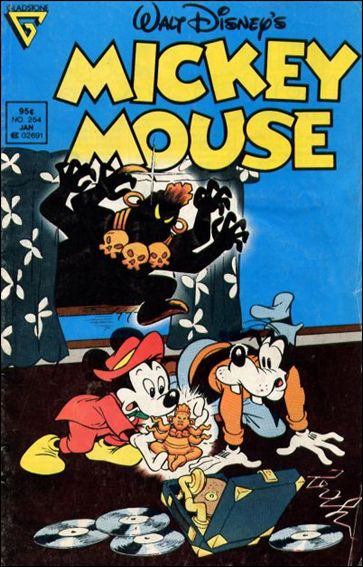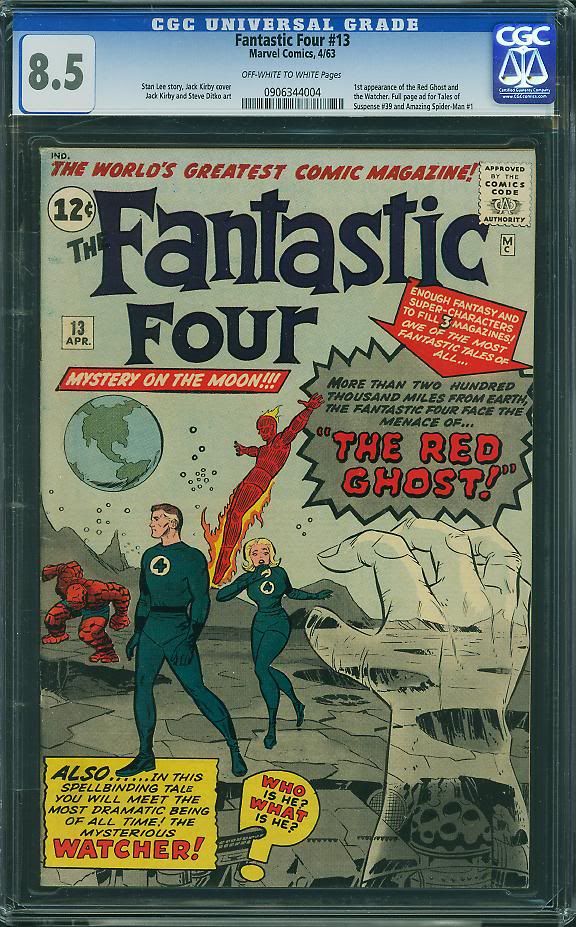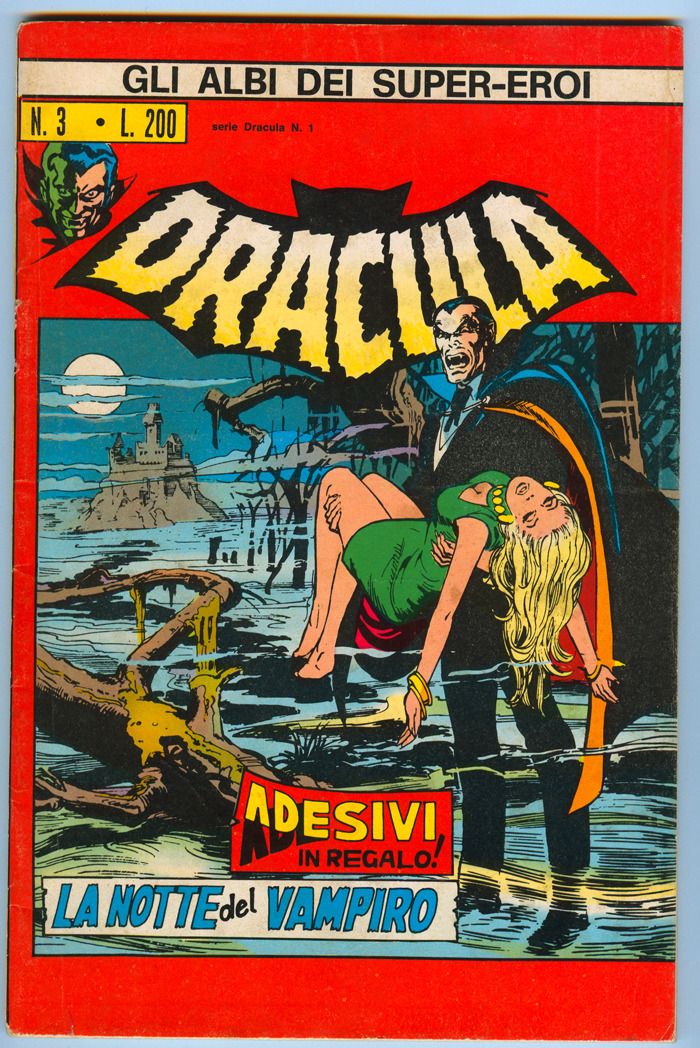-
When you click on links to various merchants on this site and make a purchase, this can result in this site earning a commission. Affiliate programs and affiliations include, but are not limited to, the eBay Partner Network.
-
Posts
21,123 -
Joined
Content Type
Forums
CGC Journals
Gallery
Events
Store
Posts posted by vaillant
-
-
Generally you don’t have this problem (cover creases) with DIsney italian comics of the 1930s and 1940s, since they were printed on an uncoated, heavier and a little porous paper. That Donald Duck however, appears a late issue, I see it has Jack Bradbury art, so I guess 1950s…?
-
Wow. It looks VF+, and the cover art is great! I vaguely remember the story, which I probably have read in translation.
-
@drummy: #36 is one of the most accomplished covers among the first 50 ones. The composition, the whole idea, the color scheme are gorgeous. My copy is pretty nice, but I can’t imagine how a professionally graded NM copy would be in hand… Just great.

-
While I have read a number of the reprints in the Gemstone series it is hard to understand the significance or depth of the history involved. I have a beautiful Italian volume of Donald Duck but can't read it unless I painfully try and figure it out. The artwork is beautiful though.
I was in Europe in 1982 as a young man and was amazed at the stores selling beutiful graphic novels in France at that time. It simply blew away anything being offered in the US at that time. I was also pretty impressed to see theaters showing only animated Disney cartoons. I stopped in to catch some classics.
I would love to be able to read some history of this material.
I assume with "reprints" you mean the first foreign editions of a story (I do not use the term because I wouldn’t refer to – say – italian editions of Marvel comics as "reprints" but simply as foreign first editions).
But again, this example fails to explain the relevance since Marvel have not had foreign "schools" picking up the essence of the original productions (with little exceptions).
As I said, to properly appreciate the whole italian Disney comics production, you should have been able to read the best stories with a consistent continuity, a thing the various 1980s and 1990s Disney publishers were not able to attain. One of the reasons is precisely the one you mentioned: in 20-30 years of "misuse" Mickey, but also the other characters, were reduced mostly to merchandising icons.
In Italy we have had a never interrupted production starting in the late 1930s, kicking in in the late 1940s, and keeping a high-quality standard up to the 1990s, or at least up to the late 1980s. The last decade of production showed a lack of inspiration on the writers' part, while the artwork continues to be often excellent.
But the artwork alone does not make a good Disney comic, or any good story for what matters.
If you’d like to read about the italian school, whose stories – it must be said – have been translated and appreciated in almost the whole world – except USA (where I think the first italian story by Martina/Scarpa has been published in 1987), you should read this book:

Published in the early 1990s, it chronicles the whole story, foreword is by Carl Barks. I am a friend of the authors, and a new edition is going to be published soon, it would be great to have some US publisher willing to present it there.

-
Only because there have been so many of these battles over the years.
However, in the beginning, when the Thing had not met the Hulk, all Marvel readers were BEGGING for a confrontation between these two. […]
I think this is one of those "you had to be there" moments to fully appreciate these stories as we did in 1962-65.
Hi Owl,
actually in some way I *was* there. As italian readers we have had the privilege of reading the early stories side-by-side with the early 1970s production, and you can’t imagine how entusiastic I was when I read my very first Fantastic Four early episodes (the Kurrgo and the Puppet-Master episodes remain among my very favorites).
But I never wondered who would have won over who when I was 9. I was already wondering why people were so excited about seeing the Thing meet the Hulk, or Thor, or whatever. I was a lot more intrigued by plots and the personal vicissitudes of the characters rather than fights. Of course, physical fights were often interesting, but to me they have often been the less interesting part of many stories.
In any case, I would have been with the Thing, even if I like ol' Dr. Banner.

-
IMO, Hulk-Thing battles are overrated, anyway…

-
I’m wondering if there’s still some surviving Mickey Mouse fans in the States, it looks you’re all over the ducks…

The Gottfredson reprints are nice but limited in audience and other than the game Epic Mickey there has been no compelling reason for folks to connect with Mickey in a long time. He really became a corporate icon in the seventies / eighties and the Disney machine has kept him that way. There have been some surprising marketing moves to make him more relevant lately but he remains more of an Icon than a character to discuss and celebrate.
Hi 40Yrs, thank you.
I suspected that when I visited Los Angeles in 1991.
Of course, we abroad we knew Mickey went somewhat "downhill" when Gottfredson stopped developing the classic masterwork storylines side-by-side with his fellow writers, but for us italians is quite an unbelievable perspective, since by God’s grace we had people like Guido Martina and Romano Scarpa which at the time Gottfredson was giving up to produce short gag strips, were just kicking into high gear with absolutely *stunning* stories of both mices and ducks, so to speak.
I assure you these stories, especially after the italian authors' efforts became mature, have nothing to envy to some of Gottfredson's or Barks' production.
In fact, mostly Scarpa early work is very "american" and "universal" at the same time.
People like Scarpa or Giovan Battista Carpi declared many times that the Disney classic animated features, and the work of Gottfredson and Barks have been their core inspiration, in such an high way they tried to "transfigure" them in their work, and I dare to say they managed to get at the same levels.
Unfortunately you did not have so much stories published in the US, and mostly they were presented scattered here and there, not in a chronologic fashion, so unless you are a very motivated fan, most people missed a good part of them.
But if you read, for example, "Kali's Nail" or "The mystery of Tapiocus VI" you’ll see what I mean. They are quintessential classic, in many ways.


The following are from the "freudian-inspired" story "Topolino e la collana Chirikawa" (unpublished in the US), which featured a "trip into the depth of the soul" of Mickey Mouse, as he revives fragments of his childhood recalling his very first meeting with Peg-Leg-Pete:


This other one is the splash page of another all-time classic (also unpublished in the US): "Topolino imperatore della Calidornia" ("Mickey Mouse, emperor of Calidornia"), a sort of "how the west was won" storyline which explains how a Mickey Mouse ancestor‘s lecacy would actually put Mickey in possession of the whole Californian state ("Calidornia", in the mice geography devised by Scarpa, in an ever-ending homage to the original US roots of the characters):

This eventually shows a never seen before Mickey which risks to be seduced by the very idea of richness and wealthy possessions, whose short-lived daydreaming is broken up by Minnie, because of which Mickey arrives too late to gain possession of the legal document which would make him proprietor of the state.
In both stories, Mickey’s sideckick is not Goofy or Eeega Beeva, but an ingenuous character created by Scarpa which is an "enlarged living atom": Atomino Bip-Bip.
Atomino is the creation of Professor Einmug, and debuts in the story "The Delta dimension":

which has been published in the US on Mickey Mouse Adventures (Gemstone) #11 in 2006.
It‘s a real pity that Disney USA, Gladstone and Gemstone, put so little effort in publishing those stories, which would delight most people which are fond of the Gottfredson and Barks classics.
-
That’s cool. Whiteness of the cover paper becomes particularly relevant when you have a cover which relies on white for its beauty and effectiveness.
For example, I’d love to have a white-covered Fantastic Four for that issue where the Warlock cocoon is at the center of the composition. It‘s a highly dramatic story, relevant for the issues it brings in (biogenetic engineering, blind faith in means of merely technical applications of science), and most of the cover compositions have a sense of "impending doom" to them. One of my favorites.
-
What’s it about this Twin Cities collection? The white pages?
-
Anyone else still out there?

It got awfully quite in here all of a sudden.
Blame it on those arrogant guys which built the Tower of Babel…

-
I’m wondering if there’s still some surviving Mickey Mouse fans in the States, it looks you’re all over the ducks…

-
P.S. The book is unpressed....I'm real happy with it. It might press into a 9.0, but I'm keeping it like this now.....but part of me really wants it in a mylar...
Listen to the voices…

(I am quoting Omega the Unknown).
-

This is my favorite FF cover. There's a beautiful TC copy just sold recently on Clink.
I bid on it to a point but then it went to silly money, well at least for me

Great book

Hem… How much silly?

-
Hey guys.... I would like to thank boardie Vaillant for helping me out with this one! This is the Italian Tomb of Dracula #1! It is a really cool book, but what makes this one soooo freakin much cooler is the addition of the original stickers that came with this issue. These are hard to find still on the sticker back and from what I have been told even rarer still attached to the book by the staple. Maybe Vaillant and other Italians can give us a lesson on the included stickers that came with many of the Italian issues?
 Earlier in this thread it was talked about how CGC lacked a way to identify properly what foreign books had stickers and what did not? And even if they did there are for sure graded Italian books floating around out there without this sticker notation? Interesting for sure.........
Earlier in this thread it was talked about how CGC lacked a way to identify properly what foreign books had stickers and what did not? And even if they did there are for sure graded Italian books floating around out there without this sticker notation? Interesting for sure......... 

I will be glad to do it, but actually it is a lot simpler than what one might expect:
Editoriale Corno started to include stickers with the earlier issues of each series.
Then, they occasionally put them once again for a sequence of numbers, during the various series runs. Most of the "anniversary numbers" have them (and occasionally they have posters as well).
Identifying them is very easy, as the thing was always notified on a cover blurb saying something like "contiene adesivi" "qui adesivi", "qui adesivi e manifesto", "contiene poster" etc.
As you see, here in the ASE #3 (which includes Tomb of Dracula #1 anfd #2 if I recall correctly) the cover blurb says "Adesivi in regalo!", which means "Free stickers!". (thumbs u
-
Every comic book will eventually be sold (or they'll all become worthless). So you have to ask yourself...is this the best book to hold at the moment or is there something better? If there's something better, then maybe you sell what you have and take another position. if not, hang on for the ride!
@CC: Why do you say "They’ll all become worthless"?
Worth of a comic book (or of a book) is not measured in money. The acquired monetary value is just an indicator.
-
Not sure why, but I see those crazy moiré patterns quite a bit with this issue. Something about the dot pattern in that funky purple background must wreak havoc with a lot of scanners.
The more a color comprises percentages of all of the four process colors, the more moiré will be likely to present itself, so with colors like purples, browns, dark greens and dark colors in general, it will be more visible.
Best solution to avoid moiré on screen pics is to scan at high resolution, then reduce to screen size.

-
Comics bagging and boarding started consistently in Italy in the late 1980s-early 1990s, thanks to the start of original editions collecting.
The pratice of bagging comics has always existed, but it was inconsistent, largely depending on the issues format (1930s and 1940s material is more than often journal or tabloid sizes and people tended/tend to bag entire year runs), pvc or bad materials bags were ofter used rather than polypropilene and mylar is still largely unused, since there is no local production.
I myself don’t like mylar (especially thick mylar) because it takes a lot of space.
For the same reason, for years I have constantly bagged books, but boarded only the silver age and some bronze age issues. Most moderns are bagged without board, except issues I liked particularly or felt were more delicate.
-
Colors in the Australian editions are all screwed-up, like they occasionally did in France. Ugh.
-
Thanks everyone. I had a question. How many of the FF collectors have a complete FF set to current issue? I see alot of people state they are collecting FF #1 to say 100. Or a number they feel is a good place to stop. So how many FF fans still have a sub in a LCS that pulls the new issue of FF for them every month, and have the whole set to present. I can start that club now.
 Newest issue I have is #604...but I have not gone to get my sub in a bit. Could be a newer one.
Newest issue I have is #604...but I have not gone to get my sub in a bit. Could be a newer one. I am pointing to complete the collection, sooner or later. I still miss a good part of the earliest issues (lowest I have is #3), and I started buying them selectively in the last 15 years, because it was more a pain on my side than enjoyment seeing the characters so badly handled.
In the end, I think Pacheco had the required background/awareness to write them, and did a great run, Straczynski did about decently.
The editorial policy of Marvel in more recent years have become almost totally inconsistent to me, and most writers aren’t concerned at all about the characters.
-
BTW I knew about the Da Nang letter and the Spider-Man Vietnam related letters. I don‘t know where he read about them, but a friend of mine wrote about this about the meaning of the Marvel Age in an article we did (I think the article was about Kirby's Fourth World).
Letter pages are among the best things, that’s a very good reason to collect even single issues of the original publications.

-
I've often wondered if I have wasted a lot of time and money over the years collecting comic books. Do real people actually consider them important? I've wondered why I am still pursuing what was essentially a childhood pastime, only now many years later those 'silver age' books are expensive.
I don’t get what you mean by "real people".
I also don’t get why you are wondering about considering them "important". A pastime is important as much as any other aspect of your life, especially an uplifting pastime. Of course, I am talking of good narratives (be them literature, narrative, comics et al.), narratives which enrich you, rather than impoverish you.


I guess I was replying precisely because the problem was already there in your post, right?

-
I've often wondered if I have wasted a lot of time and money over the years collecting comic books. Do real people actually consider them important? I've wondered why I am still pursuing what was essentially a childhood pastime, only now many years later those 'silver age' books are expensive.
I don’t get what you mean by "real people".
I also don’t get why you are wondering about considering them "important". A pastime is important as much as any other aspect of your life, especially an uplifting pastime. Of course, I am talking of good narratives (be them literature, narrative, comics et al.), narratives which enrich you, rather than impoverish you.
-
Maybe they left the english balloon to keep the "exotic" foreign feeling. Japanese mangakas since the 1990s started to use english titles, or english blurbs, which IMO shows how they lack the proper background (again). You have no need to reference a language just because it's "cool". It’s childish, if that was the only reason for it.
Very curious to see a hindi publication which seems pretty contemporary with a cover with little to no graphic design, evoking 1970s design at best. That Mickey Mouse videogame ad is unreal within such a book.
I forgot: the "Super-Eroe" series was pocket-sized, while Gli Eterni was magazine sized (so was "Il Corriere della Paura", printing Marvel horror material, and "Dracula" – after the closing of the ASE series Dracula continued on these two magazines, in black and white, up to 1976. Then we never had another italian edition of Dracula.
-
Comic book readers are more accustomed to a very realistic Mac Raboy. His realistic style on Flash Gordon is also pretty different.



List of GA dealers online...
in Golden Age Comic Books
Posted
Hi Ken, thank you.
At first sight, your site looks nice. I like the possibility to see decent-size pictures beforehand without having to ask via email. :-)